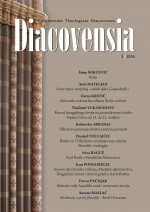POVIJEST GRADNJE ĐAKOVAČKOGA SJEMENIŠTA
CONSTRUCTION OF THE SEMINARY IN ĐAKOVO: HISTORICAL BACKGROUND
Author(s): Marina BagarićSubject(s): Christian Theology and Religion, Cultural history, Architecture
Published by: Katolički bogoslovni fakultet u Đakovu
Keywords: Đakovo; Theological Seminary; Ivan Krapac; Josip Vancaš; Dionis Sunko; neo-styles; Secession; Art Deco; folklore motifs;
Summary/Abstract: The Diocesan Seminary in Đakovo was situated in the Baroque building of the former Franciscan monastery for more than a century. In 1908 the architect Josip Vancaš (born in Sopron, Hungary, in 1859; died in Zagreb in 1932) made the project of the full adaptation of the Seminary. However, in 1911 a decision was made to build a completely new building. The project was developed by Dionis Sunko, architect from Zagreb (Sisak, 1879 – Zagreb 1935). Sunko managed to functionally include different aspects of the seminary life. Certain spatial solutions, primarily the one made for the façade and the interior, showed the architect’s exquisite sensibility for the context. He respected the local folklore tradition and, according to his own words, the vicinity of the Bishop’s Palace had inspired him to use the elements of Baroque formative style. In the interior design and the details on the façade we can find certain Secession motifs as well as those close to Art Deco suggestive style expression. This audacious combination of the elements of various styles is unique in the Croatian architecture of the fi rst decades of the 20th century.
Journal: Diacovensia: teološki prilozi
- Issue Year: 14/2006
- Issue No: 2
- Page Range: 707-731
- Page Count: 25
- Language: Croatian

